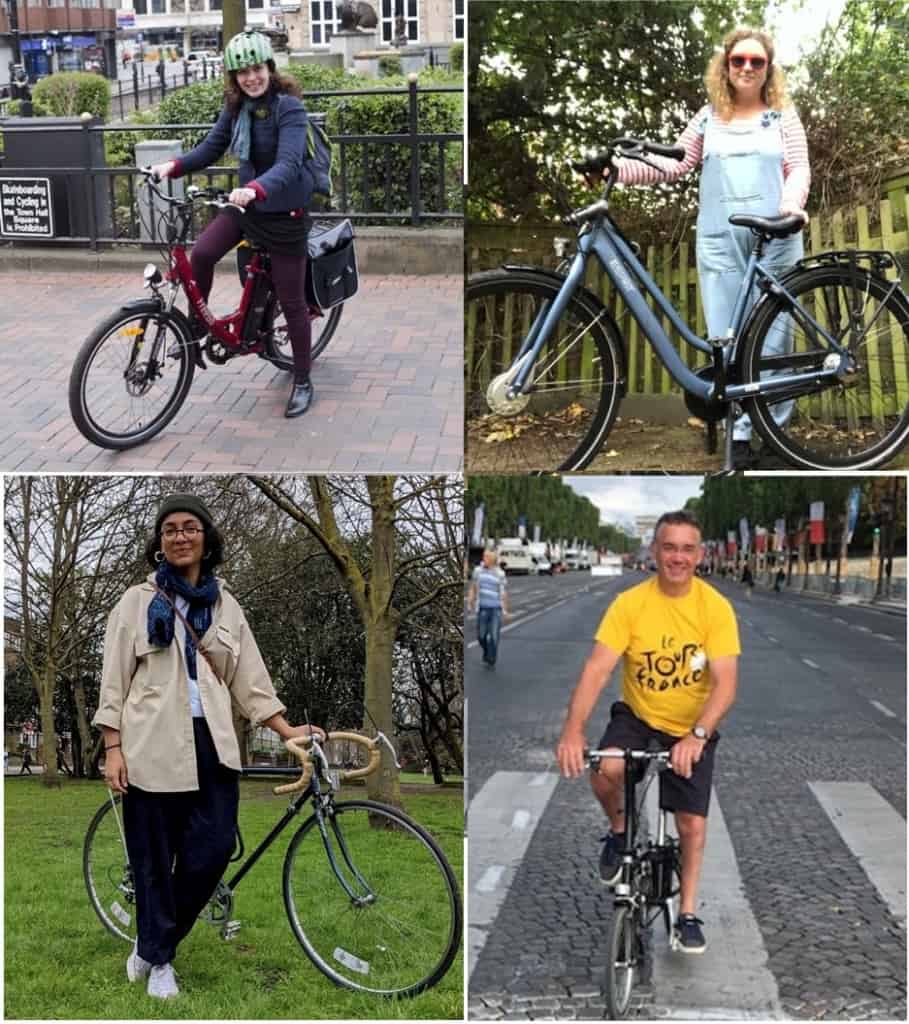
Can you spot the odd one out?
It’s the cyclist in the bottom left image. The other cyclists are all Disabled cyclists.
When we talk about Disabled cyclists, we often talk about cyclists who use non-standard cycles. There are some good reasons for this: people on non-standard cycles face the greatest infrastructure barriers, have the least representation, and have the fewest options for accessing cycles. But many Disabled cyclists have hidden Disabilities, and most ride a standard two-wheeled bicycle. Hidden disabilities are one of the themes of this year’s UK Disability History Month, so we thought we’d look at a few cyclists with hidden Disabilities.
There are many reasons why Disabled people who can cycle choose to do so: it keeps you fit, supports your mental health, allows for independent travel, creates opportunities for social activities, is a non-weight bearing form of exercise, and can be easier than walking. For many Disabled people, their cycle is their mobility aid. This is equally true for people with ‘hidden Disabilities’: someone may be cycling easily on a two-wheeled bike, might dismount and stand with it, or even walk a short distance with it, but their cycle may still be essential to them as their mobility aid.
For someone with arthritis, chronic pain, talipes (club foot), an amputee, or someone with a similar joint or foot impairment may find walking painful, or may only be able to walk a limited distance. Cycling is non-weightbearing form of exercise, which puts less pressure on feet and joints. It can increase the distance someone can travel from a few metres to a few kilometres – or more!
It can also help compensate for limited balance. Some people who are unsteady on their feet find it easier to balance on their bike, and when dismounted a bike can be used inconspicuously as a rollator.
Cycling can be less overwhelming or overstimulating than noisy or crowded public transport for neuro-diverse people as well as those experiencing mental health difficulties.
Finally, cycling can help people with hidden Disabilities manage their symptoms. Some people with
epilepsy find that physical exercise reduces the frequency or severity of seizures. Likewise, exercise has also been found to help people with mental health conditions such as chronic depression, anxiety, and ADHD. People suffering from chronic pain may find sitting still for long periods painful, so the steady movement of pedalling makes cycling more comfortable than sitting in a car or on public transport.
Although cyclists with hidden Disabilities are less likely to encounter a high number of barriers to cycling than more ‘visibly Disabled’ cyclists on non-standard cycles, they still face many challenges. Not all Disabled cyclists on a two-wheeled cycle can dismount and lift their cycle up steps, or wheel their cycle through a gate or pedestrian area. Some can dismount, but rely on using their cycle as a support while they walk. However, because they don’t “look” Disabled, many Disabled cyclists on standard two-wheeled bikes receive verbal abuse, are told to leave shopping malls, stations, and other pedestrian areas, or are threatened with arrest.
It’s vital that more people – public, security officers, staff, drivers – become aware that many Disabled people cycle, and they won’t always be on a non-standard cycle. Someone may need to wheel their folding cycle into public building on onto public transport, rather than fold and carry it. Someone may need to cycle – with due care and at a reduced speed – through a pedestrian area, because their bike is as much a mobility aid as a mobility scooter or wheelchair. Heavy and/or fast traffic add another barrier – hence the importance of accessible, protected cycle-lanes for all cyclists.
We need legal recognition of cycles as mobility aids for Disabled people, and a ‘cycling blue badge’ to allow Disabled cyclists to indicate that they are Disabled and need to use their cycle. In the meantime, we also need greater awareness and inclusion of Disabled people on all forms of cycles – including bikes! – by public and staff. If someone is cycling carefully and sensibly on their bike in a pedestrian area, don’t ask them to dismount: their cycle might be their mobility aid.
We’ve picked out a few stories by Disabled bike-riders from our blog – put the kettle on and have a read:
https://wheelsforwellbeing.org.uk/aisling/
https://wheelsforwellbeing.org.uk/deb/
https://wheelsforwellbeing.org.uk/mike/
https://wheelsforwellbeing.org.uk/mags/
https://wheelsforwellbeing.org.uk/billy-2/
